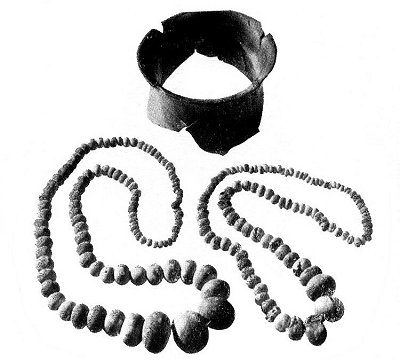The site of a fortified settlement at Dívčí Kámen (Girls´ Stone)
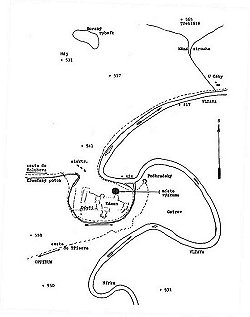 There used to be a
settlement on the rocky knoll above the confluence of the Vltava
River and the Křemežský Stream in the Primeval Times. The location
of cliff raising above the Vltava Basin predetermined the place of
settlement - probably a very important strategy point on
presumptive thoroughfare leading from Podunají area to Central
Bohemia.
There used to be a
settlement on the rocky knoll above the confluence of the Vltava
River and the Křemežský Stream in the Primeval Times. The location
of cliff raising above the Vltava Basin predetermined the place of
settlement - probably a very important strategy point on
presumptive thoroughfare leading from Podunají area to Central
Bohemia.
The archaeological research done by dr. J. Poláček from the South Bohemia Museum in the town of České Budějovice in 1960´s and 1970´s allowed us to get acquainted with present state of the locality. He drew his attention to the north slope of castle knoll (picture 1). Primeval discoveries were excavated in layers swept away by means of water, mediaeval ground levels and rarely in original primeval situations. The independent archaeological research of the mediaeval castle centre situated on the hill-top was done by dr. A. Hejna from The Institute of Archaeology in Prague. It proved that mediaeval building up had destroyed all older settlement situations (The Castle at Dívčí Kámen - construction in progress).
Very rare discoveries of pottery vessel fragments prove the knoll settlement in the late Stone Age - Eneolith (approximately 4000 - 2000 BC). That period in South Bohemia has been known very little so far. Mentioned discoveries are the only evidence of that period settlement in the Český Krumlov region.
The site of a fortified settlement (later the mediaeval castle) was built on that place at the turn of the late and middle Bronze Age (approximately 1500 BC). We know very little about its appearance, fortification or development. However, we can surely assume it was well-fortified like many other those days sites of a fortified settlement in South Bohemia, for example, Vrcovice, Skočice, Nuzice. The most pieces of information about the people living in the site of a fortified settlement (later the castle at Dívčí Kámen) come from discovered articles. A collection of discoveries from that locality is deposited at the South Bohemia Museum in the town of České Budějovice. It ranks among numerous collections of that age (the turn of the late and middle Bronze Age in South Bohemia).
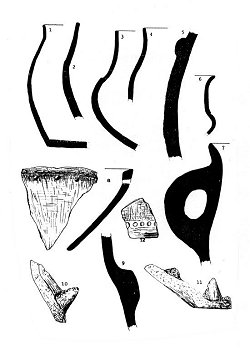
|
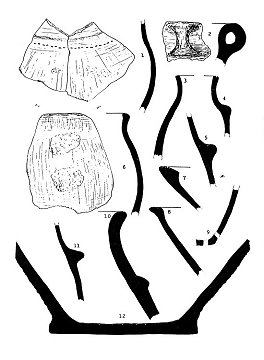
|
The discovered collection contains pottery vessel fragments ( picture 2 - 3 ). There was a wide selection of shape varieties in the Bronze Age. Large vessels - " storage vessels " were used to store food. Frequently used pot-shaped and amphora-shaped vessels appeared most. Different types of bowls are also very numerous. They drank out of pottery cups. Miniature containers could have been used as toys. Pottery dating from the turn of the late and middle Bronze Age prove potters´ learned technique and skill those days. Vessels were made without using a potter´s wheel and baked quite well. Some of them have a rough outside surface to touch in order to prevent hand slipping. On the other hand, smaller amphora-shaped cups have a very smooth surface. Such a surface finish indicates that such vessels were used as "table" pottery. A pottery decoration was very simple in the late Bronze Age. A plastic dent tape with plastic ledges was usually used. Engraved decorations with white filling appeared only rarely.
An exceptional collection of non-pottery discoveries comes from the site of a fortified settlement at Dívčí Kámen compared to other places of discovery. Most of them were discovered during the archaeological research. However, some collections were excavated independently. A depot ( a mass discovery ) of bronze bracelets was discovered at the foot of the castle knoll. Although we do not know the exact number, several examples were preserved. For example, very luxurious jewels those days - spiral bracelets with rose-shaped ending ( picture 4 ). Another depot was discovered in the north slope of castle knoll in 1960. Two bronze axis, two cuff bracelets and 250 amber beads in different size ( picture 5 ) were hidden in a large pottery vessel. Amber was very popular with people. Beads and necklace pendants were made of it. However, that material had to be imported from the Baltic Sea area to Central Europe. It was highly treasured. Amber beads from Dívčí Kámen are an example of the most numerous mass discoveries in Bohemia. They also prove long-distance trade. The local site of a fortified settlement took part in it, too.
The archaeological research produced a very unusual extent collection of bronze articles or just fragments, mostly jewels (bracelets, rose-shaped rings), tools (axis, awls) or weapons (daggers). One dagger has its wooden facing going on handle still preserved. Wooden parts of bronze industry have been preserved only exceptionally. The amount of bronze articles found in the site of a fortified settlement reflects its exceptional importance.
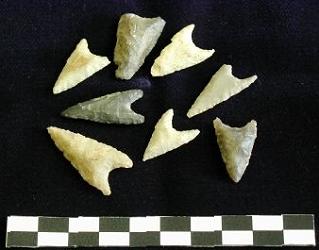
|

|
A collection of products made of stone is also considerable. Production of arrow spikes made of silex was widely spread (picture 6) at the turn of the late and middle Bronze Age. It ended a long lasting tradition of fissionable industry production. The tradition of cut stone industry - different types of axis and hammers ended up in the late Bronze Age. Several miniatures are also known from the discovered collection at Dívčí Kámen. Those articles did not have any practical importance and can be included among discoveries with symbolic or ritual function (picture 7).
Not many discoveries are known from the surroundings of the site of a fortified settlement at Dívčí Kámen. However, some grave-mounds have been discovered in forests near a village of Třísov - some bronze spiral targets, clothing decorations dating from the late Bronze Age. We are not sure whether those grave-mounds reflect to the place of eternal rest or are closely connected with another unknown settlement in its surroundings. The site of a fortified settlement at Dívčí Kámen was not isolated. Numerous discoveries in the České Budějovice area definitely proved that. There was a settlement in Vyšný near the town of Český Krumlov.
The location of the site of a fortified settlement remained forsaken for several centuries after the settlement dating from the turn of the late and middle Bronze Age had come to nothing. Some pottery vessel fragments prove human presence in the late Iron Age, the Halstat Period (7th - 8th century BC). The castle was built there in the late Middle Ages.
We have learnt very little about the site of a fortified settlement at Dívčí Kámen so far. Even though the discovered collection is quite numerous. Archaeological researches may uncover much more in the future. We are sure the site of a fortified settlement was very important.
(jm)
Further information :
Archaeological
Researches in the Český Krumlov Region
Primeval
Settlement in the Český Krumlov Region
Primeval
Sites of a Fortified Settlement in the Český Krumlov
Region
Mass
Discoveries (called depots) from the Bronze Age in the Český
Krumlov Region



